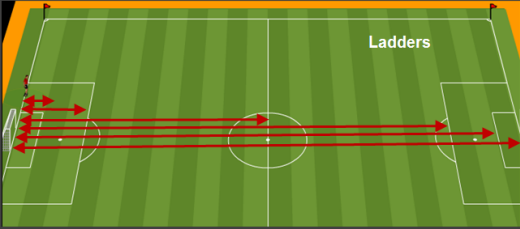Conditioning for Soccer Tips and Principles
Before you start Conditioning for Soccer make sure you understand some of the principles behind becoming soccer fit.
Use these conditioning for soccer tips to ensure you are growing and maximizing your conditioning.
Principle/Tip #1
Iíve said it a bunch of times. If youíve read my stuff you understand that I am not an advocate of using long distance running to train for soccer. It can harm your speed and power and its not like the game of soccer. Itís old school.
Principle/Tip #2
At any given time all three energy systems are working. You are really never exclusively using aerobic, anaerobic etc. But, one of the energy systems does predominate. Usually the system that dominates is based on intensity and duration of the exercise. Go out for a 30 minute run and the aerobic system will be your primary energy system.
Principle/Tip #3
Work + Work = Over Training
Work + Rest = Growth
It is not during your exercise routine that you grow. It is during rest that you grow. Make sure you strike a fine balance between work and rest. I know there are many over exuberant players who want to go pro and make it big. They will do anything their coach and trainer tells them and more. But, you have to rein it in sometimes to allow your body a chance to rest and give your body a chance to grow. If you condition all the time you will probably find yourself sluggish, lacking in speed and power, and not performing at your best. Have you ever noticed a couple weeks after your soccer season you feel faster, and can jump higher than during the season? To me the reason this happens is because you are rested and your body has grown from all the in season work. Plus the season takes its toll. SO make sure you get a good amount of rest.
Principle/Tip #4
Soccer Conditioning Principle #1 stated to not do long distance running. With that you will be forced to do more short distance running which means higher intensity. Do not do high intensity exercise every day-this is a recipe for disaster. 5-7 days a week of high intensity conditioning is too much for the body to handle. An example of high intensity exercise is ladders. Ladders involve running as fast as you can from the end line to the six yard box and back, to the 18 yard box and back, to the mid line and back, to the next 18 yard box and back you get the point. If youíve done these you know they are killer. For young players the form of ladders I outlined will be too much. It's ok to shorten it for your target group.

Principle/Tip #5
Do not condition the day before a game or the day of a game. You need to be fresh and perform at your best. The exception to this rule applies to substitutes who do not play much. You need them to stay in top condition in case they get into a future game, or are required to play starters minutes. Imagine your soccer conditioning during the season consists of two to three days a week if you include the game as conditioning. The starters and those that play significant minutes get the 2-3 days of conditioning. Those that donít play much will only get about 1-2 days of conditioning because we canít count the game.
To give your bench players significant conditioning have them do it after the game. A simple and good exercise for bench players (who donít play enough) is the ladder. The repetitions depend on the age and sex of the players. So pick a good range that works for your players and start there. If a player that plays significant minutes goes down with an injury youíll have a better conditioned player ready to step in.
Principle/Tip #6
How do you train aerobically without long distance running? That is a great question. The interesting thing about some short distance running is that it can actually improve measures of aerobic training. A study looked at two training methods. One was training at moderate intensity (70% of max oxygen uptake 60 minutes a day 5 days a week for six weeks). The moderate intensity program did not improve anaerobic capacity significantly while Vo2max increased from 53 (ml-kg-min) to 58 (ml-kg-min). The second training protocol used high intensity intermittent exercise 5 days a week for 6 weeks. The program consisted of 7-8 sets of 20 second exercise at about 170 % of VO2max with 10 seconds rest in between. After implementing this training protocol, anaerobic capacity increased by 28% and VO2max by 7 (ml-kg-min). So you see that the ďTabataĒ training protocol actually did better in both realms.
Whatís interesting is the high intensity group only actually exercised for a total of 140 to 160 seconds while the moderate group exercised fully for 60 minutes. (1) Which seems more efficient to you?
Before you get out and start doing this routine itís important to remember that more than likely it was adults who did the program not young children. This is not a program for young kids. I am not recommending it.
I simply point this study out to show high intensity exercise is more efficient and works both energy systems while moderate intensity seems to limit the affect on the aerobic system. So please do not put your very young kids on this protocol. Consult with a trainer before putting any of your young athletes on this program.
If you are looking for a fitness program for young athletes that trains aerobically and anaerobically without long distance running check out
